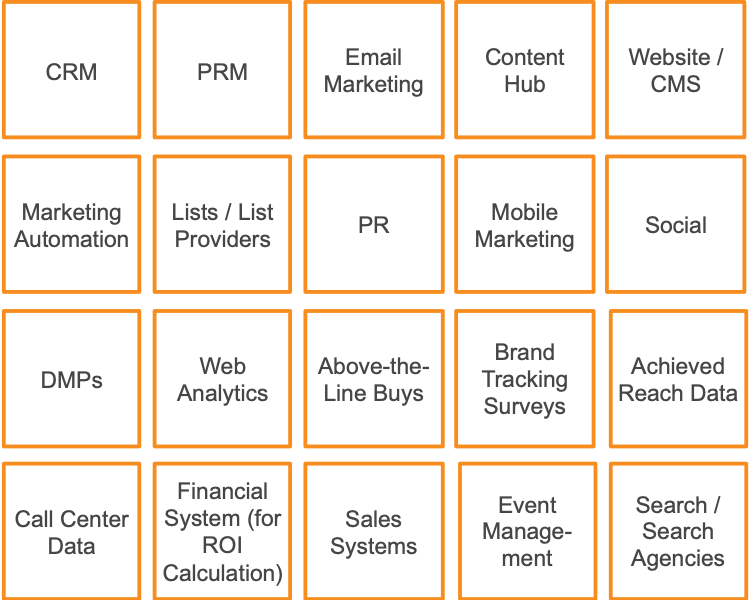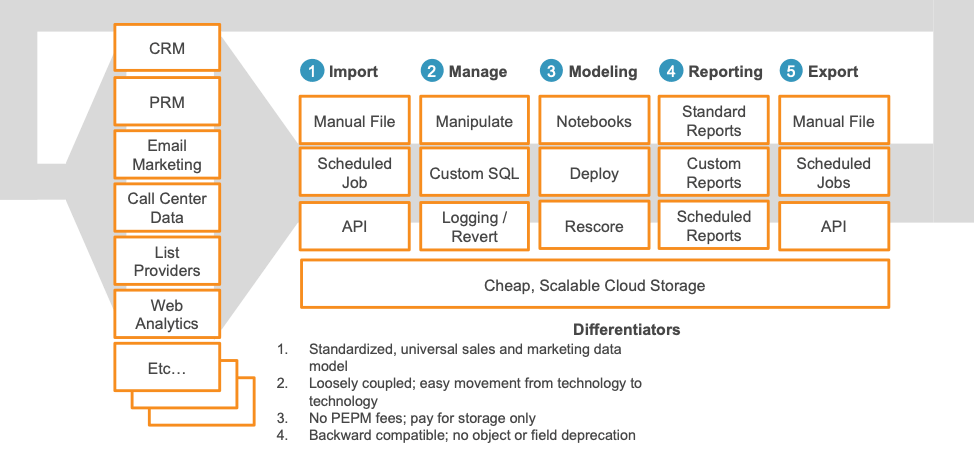The Promise of the Marketing Data Platform
Sales and Marketing Datapalooza
After twenty years of continuous innovation, marketing and sales technology is ubiquitous, extremely powerful, and very expensive. A typical sales and marketing organization spends upwards of 25% of its budget on technology, broadly defined as the software, data, and infrastructure to communicate, track, optimize, and analyze go-to-market activities.
These technologies include (but are not limited to) CRM (customer relationship management), marketing automation, partner relationship management, email marketing, web analytics and management, mobile marketing platforms, content hubs research platforms, data science platforms, and data warehouses, to name a few. Each of these tools provide robust data storage and analytics capabilities—making it possible to build dashboards, reports, and models in Salesforce.com, Eloqua, or Marketo, etc., etc.
Figure 1: Sales and Marketing Datapalooza, or an incomplete list of sales and marketing data sources. The array of data sources required to instrument all of the sales and marketing efforts of a company are dizzying.
However, these dashboards and reports immediately become siloed, as access to each is available only through the few domain experts in these tools. For larger enterprises, the solution to this problem has traditionally been a custom-built marketing data warehouse, integrating all sources via batched loads from the various systems, and accessed via a business intelligence platform. These solutions work, but they are expensive to build and maintain, and when new technology is added, a new IT project must commence, delaying access to integrated data for months or years.
One other solution that has emerged in the past two years is the sales and marketing data lake. In this solution, data are purposefully left unstructured. Concretely, a json instance of an inbound lead is left in its unaltered format. Keying this to other objects, and applying lookup tables to make it sensical, is left to either a data scientist further downstream, or to the reporting system that eventually displays the data to an executive. This is a tempting solution because it bypasses the expensive and complex process of structuring and maintaining the data warehouse, but it’s kind of a copout; while it’s true that reproducible approaches to data science and reporting can make this a more scalable solution in 2018 than it was ten years ago, a mess is still a mess.
The PEPM Trap
Compounding the difficulty of integrating the data exhaust of multiple platforms is the never-ending march of increasing PEPM (per employee, per month) software licensing agreements for software vendors. In the not-so-distant past, enterprises could control their software cost exposure by purchasing software outright and either choosing to include maintenance or “go it alone”. This hemmed in financial risk and made it easier to pick-and-choose what software was truly needed at any given time.
Over the past ten years, however, this model has essentially disappeared in lieu of PEPM models. Shareholders and VCs love the PEPM model, because it drives great financial projections and multiples on spreadsheets. As companies grow, revenue grows linearly. Of course, this isn’t enough—every company is trying to take more and more of the PEPM pie.
Salesforce.com is an egregious offender. For anyone who has attempted to provide additional licenses to users in an organization who only need a small percentage of Salesforce.com functionality (e.g. “just some of the data, for one use case”), it is impossible to get anything under $40 PEPM—an outrageous fee when one screen might be used per week.
This greed (because that’s what it is) has hobbled PEPM software providers over the long run, because it has made organizations unwilling to keep all of their data with them. The more data is stored, and the more customizations that are made, the higher the switching costs to move to another platform; and thus the PEPM thumbscrews are applied.
Sales and Marketing is a Unique Business Function
Every consultant laughs about the adage “my company is unique”—because it’s heard at the beginning of every new client engagement. However, laugh as they might, consultants do have a very significant learning curve at the outset of a new engagement learning the norms, standard operating procedures (SOPs), unique customer value propositions, and technology footprint of their new client. That being said, there are many more similarities than differences, and this is why enterprise software exists.
In many functions, enterprise software is mature. Accounting, operations, and HR, for example, have clear procedures, best practices, and governing bodies. There is a right way of doing accounting (GAAP); there is a right way of managing high-quality operations and manufacturing (ISO-9001). There is not, however, a “right” way of doing sales and marketing. Sales and marketing is perhaps the fastest moving area of business, because its goal—gaining the attention of customers—is one of the most dynamic things imaginable.
This is why sales and marketing technology platforms proliferate faster than a CMO can keep up with—and why sales and marketing data are such a mess.
The Solution: A Standardized Sales and Marketing Data Platform
Even though sales and marketing technology proliferates wildly, the basic data elements of sales and marketing do not. New data elements are certainly added, but the basic data structures of understanding stimulus, response, prospects, customers, companies, and transactions remain wonderfully constant. Elements of these basic structures are already built into CRM systems. Certainly, Salesforce.com would love to be your sales and marketing data platform. However, a truly unified data platform is frustratingly hard to find.
At MarketBridge, we have spent 20 years understanding every sales and marketing data element under the sun—from web leads to outbound direct marketing to weekly time series—and we realized that there is a “Platonic ideal” sales and marketing data structure. In fact, we started structuring our clients’ databases using this structure years ago. It made reporting and modeling scalable and reproducible.
Our PlayCaller platform is the marketing and sales data platform we use for all of our analysis, reporting, and optimization. PlayCaller is, at its simplest, a platonic ideal sales and marketing data structure that can accommodate almost any type of company that spends money on marketing and has customers.
Figure 2: The PlayCaller Marketing Data Platform
Of course, for a data platform to be helpful, it has to have more than a universal schema. Thus, we built PlayCaller to have several other features to help break free of the PEPM, siloed tyranny that most modern sales and marketing organizations face:
- Loosely Coupled. PlayCaller does not have any partnerships with existing sales and marketing software vendors, intentionally. This ensures that you won’t be trapped inside one system. If you switch from Salesforce.com to Microsoft Dynamics, just reverse the flow from read to write, and you’re good to go.
- No PEPM. Our clients pay for the data they use, period. Less data = lower fees. This fully leverages the promise of cheap cloud storage.
- Backward Compatible. We never deprecate a field or a data element, so your imports don’t suddenly break.
- Forward-Thinking. Continuous releases extend the data entities available in PlayCaller to work with the latest technology. The marketing technology that no one is even dreaming of today will make it into PlayCaller shortly after our first client needs it, depending on priority.
- Best Practices Built In. We make sure to code and document best practices for arranging data, building models, and reporting on results. They aren’t used for every company or every use case, but when we need to create a rolling panel time-series regression, that “module” is parameterized and can be deployed in a day or two.
- Develop and Production-Deploy Models. Data science and Artificial Intelligence are as hot as ever, but the translation layer from idea to production remains ridiculously cumbersome in most environments. In PlayCaller, models can be tested and deployed, and then fully scored lists (or objects, available via API) are quickly available. In summary, one place to get data, deploy models, and deploy to production.
- Single Source-of-Truth Reporting. With PlayCaller, executives, managers, and practitioners have one place to look for results, with no PEPM fees for additional licenses.
Conclusion: Focus on the Data Platform, Not the PEPM User Interface Software
Many executives buy into the myth that buying “that next piece of software” will solve all of their data problems. In fact, the opposite is true. By relying on CRM, marketing automation, and other “user interface” software companies to fix the data, the data just becomes more tightly entangled with their world.
By focusing instead on creating a loosely-coupled sales and marketing data platform, with inputs from and outputs to PEPM, user-interface systems, many benefits are gained:
- Data scientists can work much more quickly and deploy better models
- Executives get a clear understanding of all-up ROI
- A true 360-degree of the customer is made available, across sales and marketing
- PEPM software fees are curtailed
- If using a “platonic ideal” marketing data model, tables, fields, models, and reports don’t have to be reinvented over and over again across companies







